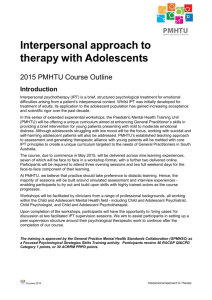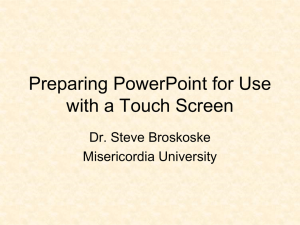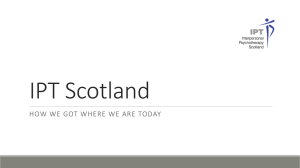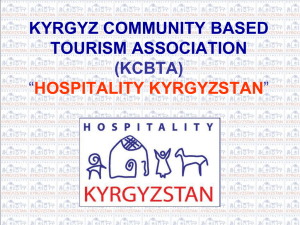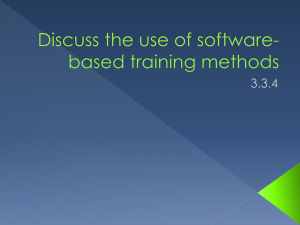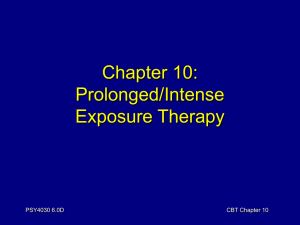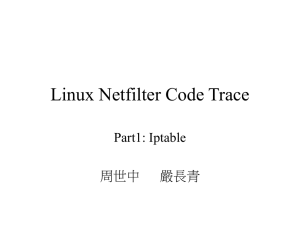Advantages - Interpersoonlijke psychotherapie in Nederland
advertisement
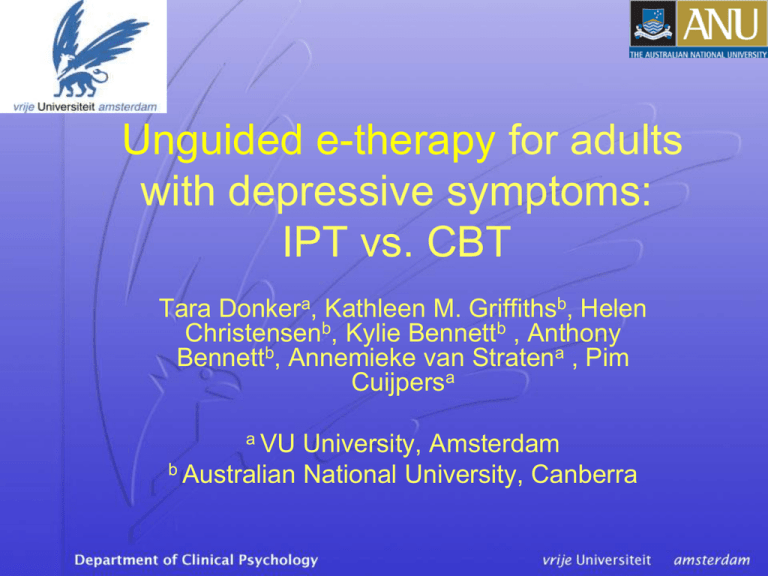
Unguided e-therapy for adults with depressive symptoms: IPT vs. CBT Tara Donkera, Kathleen M. Griffithsb, Helen Christensenb, Kylie Bennettb , Anthony Bennettb, Annemieke van Stratena , Pim Cuijpersa a VU University, Amsterdam b Australian National University, Canberra Introduction Life time prevalence: 19% (Bijl et al., 1998) Introduction Top four leading causes of burden of disease worldwide (Lopez & Murray, 1998) Introduction Costs per capita for mood disorders: € 5,009 (Smit et al., 2006) Low-intensity treatment for depression and anxiety Marijke »36 years » Single » Two children »Town »Part-time working »Mild depression Obstacles Long waitlists Obstacles 2 hrs of travelling to the clinic Obstacles Take leave from work Obstacles Arrange a babysit Obstacles Costs of babysit Obstacles +.. Costs of travelling, babysit.. Low-intensity treatment for depression and anxiety Psychological self-help: •|Standardized •Independent •Homework/tasks •Via book, audio, internet.. •Guidance by email, chat, telephone Advantages No wait lists Advantages Working from home Advantages 24/7 Advantages Cost-effective Advantages Anonymous Low-intensity treatment for depression and anxiety Intensive face-to face treatment Low-intensity treatment Obstacles Advantages • • • • • • • • Wait lists Costs of therapy etc. Time of travelling Leave/babysit Directly accessable Cost-effective Working from home 24/7 Introduction Introduction Introduction Introduction Introduction E-CBT = effective (e.g. Carlbring et al., 2009; Christensen et al., 2004;Kaldo et al., 2008; Ruwaard et al., 2009; Spek et al., 2008; Warmerdam et al., 2008) Introduction Introduction Introduction Depression: IPT = CBT (Cuijpers et al., 2011) Effect size: 0.04 (95% CI 0.14-0.21) Introduction = ? Design Internet-assisted Cognitive Behavior Therapy (CBT) & Interpersonal Psychotherapy (IPT): Design Internet-assisted Cognitive Behavior Therapy (CBT) & Interpersonal Psychotherapy (IPT): Compared to Internet-assisted CBT MoodGYM (control group) Design • Non-inferiority trial • H0: (IPT ≠ CBT) ≠ MoodGYM • H1: (IPT= CBT) = MoodGYM Design MoodGYM • Within effect size: 0.56 (95% CI: 0.33-0.79) (MacKinnon et al., 2008) • Determined sample size: N=450 on post-test Design MoodGYM • Between effect size: 0.33 (95% CI: 0.11-0.55) • Within effect size: 0.56 (95% CI: 0.33-0.79) (MacKinnon et al., 2008) • Determined sample size: N=450 on post-test Design • Non-inferiority trial • 3 e-conditions (IPT, New CBT, CBT MoodGYM) • Fully automated trial, 4 weeks • Online recruitment and screening Design • Inclusion: 18 years or older • Exclusion: currently under treatment by mental health specialist • 3 measurements (baseline, after 4 weeks and after 6-months) • Primary outcome: depressive symptoms Interpersonal Psychotherapy • Developed by Klerman and Weissman (1984) • Relationship between depression and experiences • IPT aims at improvement of interpersonal functioning and (inherent) depression Internet-assisted IPT - overview Internet-assisted IPT -week 1 Role disputes • Identification of the dispute (with whom?) • Modification of communication patterns Internet-assisted IPT -week 2 Problems making relationships • Realistic evaluation of can do`s/ can`t do`s • Increase social contacts Internet-assisted IPT -week 2 Problems making relationships Internet-assisted IPT – week 2 Internet-assisted IPT - week 3 Role Changes • Investigate which old role is given up • Validate the loss • Support letting go of old role Internet-assisted IPT - week 3 Role Changes • Develop new skills for the new role • Develop new relationships and social support Internet-assisted IPT – week 3 Internet-assisted IPT - week 4 Grief • Activate grief proces – Psychoeducation – Learn to express emotions • Finding new meaningful activities and social contacts replacing those which were lost Internet-assisted IPT – week 4 Results: Participant flow N=1993 met inclusion criteria n=69 did not fill in baseline Q N=1924 included IPT n=641 MoodGYM n=642 CBT n=641 Results: demographics • • • • • • • • Gender: 71% female Age category: 25-29 years (15.1%) Country: 1: Australia (38%) 2: United Kingdom (25%) 3: United States (19%) Education: higher degree (26%) Previous treatment by professional: 80% Been depressed before: 90% Results: depressive symptoms Mean CES-D at baseline (n.s.): • Moodgym: 35 (sd: 11.7) n=622 • IPT: 36 (sd: 11.9) n=623 • CBT: 36 (sd: 11.) n=615 Results: depressive symptoms completers only CES-D depression score 40 C BT IPT MG 35 30 25 20 15 0 4 weeks since randomization Results: depressive symptoms completers only Pre-post test: • No significant differences across the condition (F=2.018; P=.13) • Effect sizes: MoodGYM: 0.81 CBT: 0.87 IPT: 0.77 Results: drop out • • • • • • CES-D: p=.02* (higher CES-D) Sexe: p =.<0.1* (more men) Age: p =.<0.1* (25-29 years) Education: p =.04* (lower education) Condition: p = .02* (MoodGYM) Been depressed: p = .80 Conclusions Pre-post test for completers: • H1: (CBT = IPT) = MoodGYM • Effect sizes between 0.77-0.81 • E-IPT: more treatment choice • 70% “drop out” • Significant differences in drop out for demographics, treatment allocation, baseline CES-D score Discussion • ‘Gold standard’ MoodGYM: Equivalence margin: 0.33 • Follow up data not yet available • Drop out rate: 70% → » » » » Missing data approaches high symptoms: seek your GP Unguided self-help Characteristic of population Disadvantages Anonymous Disadvantages Guided self-help Disadvantages High drop out rate Discussion Unguided self-help…. • Ethical..? • Under which conditions? Questions? Thank you for your attention www.isrii.regroup.com Email: T.Donker@psy.vu.nl
